hankyoreh
Links to other country sites 다른 나라 사이트 링크
Global Hawk purchase in trouble as U.S. price tag jumps twofold

By Lee Soon-hyuk
Following the South Korean government’s announcement of plans to hasten the introduction of the Global Hawk unmanned high-altitude surveillance aircraft in the wake of the Cheonan sinking and artillery attack on Yeonpyeong Island, the United States has reportedly raised its quote for the aircraft more than twofold.
While Seoul announced plans in March to move up the introduction of the Global Hawk in order to improve its North Korean intelligence gathering capabilities, the large increase in the price may generate controversy.
Military web journal Defense 21 reported Friday that the United States recently quoted a purchase price of $450 million for four Global Hawks and demanded an additional $350 million in development costs. Taking into account demands for the settlement of additional expenses at the time of delivery reflecting the rate of increase in consumer prices, the report added that the total purchase amount would be over one trillion won, more than twice the initially predicted amount, and that operation expenses are predicted to increase by 25 percent each year.
Defense 21 also reported the United States announced its intention to install an operation station at its military base in Guam with terrestrial reception station facilities in order to operate a surveillance and reconnaissance network linking unmanned surveillance aircraft and satellites.
The Global Hawk is an unmanned high-altitude aircraft capable of observing and photographing terrestrial facilities and movements even in the presence of clouds using state-of-the-art radar and optical and infrared sensors from an altitude of 20 kilometers. The top-level strategic spy satellite weapon, which over a 24-hour period is capable of generating thousands of detailed photographs in which a single point represents 30 square centimeters, has an operational radius of some 3,000 kilometers.
The reason cited for the sharp rise in the price of the Global Hawk was a decline in demand stemming from reductions in the U.S. defense budget.
According to a Bloomberg report, U.S. Secretary of the Air Force Michael Donley stated in a letter submitted to Congress on April 12 that the per-unit price for the Global Hawk would increase by more than 25 percent owing to a 14 percent drop in the number of orders. Northrop Grumman, the manufacturer of the aircraft, also said that a decision by Air Force authorities to reduce the number of new and improved Block 40 models scheduled for production through 2015 from 22 to 11 also had a major impact. Amid this situation, the effects of U.S. defense budget cuts spilled over onto the South Korean government’s plan to introduce the Global Hawk.
The South Korean government currently has concerns over the matting. It is awaiting a response to a letter of offer and acceptance (LOA) request submitted to the United States following its decision in the second half of 2010 to introduce the Global Hawk, citing the transfer of wartime operational control (OPCON) and strengthening its North Korea monitoring system.
It also made official its plans to hasten the introduction of next-generation stealth fighters and the Global Hawk with last month’s announcement of “National Defense Reform Plan 307.”
Regarding the controversy, an official of South Korea’s Defense Acquisition Program Administration (DAPA) said, “It has not been verified that the U.S. made such a proposal.”
“There should be an official response to the LOA request very soon, and we will handle the matter through transparent discussions at that time,” the official added.
Please direct questions or comments to [englishhani@hani.co.kr]
Editorial・opinion
![[Column] Season 2 of special prosecutor probe may be coming to Korea soon [Column] Season 2 of special prosecutor probe may be coming to Korea soon](https://flexible.img.hani.co.kr/flexible/normal/500/300/imgdb/original/2024/0426/3317141030699447.jpg) [Column] Season 2 of special prosecutor probe may be coming to Korea soon
[Column] Season 2 of special prosecutor probe may be coming to Korea soon![[Column] Park Geun-hye déjà vu in Yoon Suk-yeol [Column] Park Geun-hye déjà vu in Yoon Suk-yeol](https://flexible.img.hani.co.kr/flexible/normal/500/300/imgdb/original/2024/0424/651713945113788.jpg) [Column] Park Geun-hye déjà vu in Yoon Suk-yeol
[Column] Park Geun-hye déjà vu in Yoon Suk-yeol- [Editorial] New weight of N. Korea’s nuclear threats makes dialogue all the more urgent
- [Guest essay] The real reason Korea’s new right wants to dub Rhee a founding father
- [Column] ‘Choson’: Is it time we start referring to N. Korea in its own terms?
- [Editorial] Japan’s rewriting of history with Korea has gone too far
- [Column] The president’s questionable capacity for dialogue
- [Column] Are chaebol firms just pizza pies for families to divvy up as they please?
- [Column] Has Korea, too, crossed the Rubicon on China?
- [Correspondent’s column] In Japan’s alliance with US, echoes of its past alliances with UK
Most viewed articles
- 1[Column] Season 2 of special prosecutor probe may be coming to Korea soon
- 2‘We must say no’: Seoul defense chief on Korean, USFK involvement in hypothetical Taiwan crisis
- 3Division commander ordered troops to enter raging flood waters before Marine died, survivor says
- 4Is N. Korea threatening to test nukes in response to possible new US-led sanctions body?
- 5Is Japan about to snatch control of Line messenger from Korea’s Naver?
- 6No good, very bad game for Korea puts it out of Olympics for first time since 1988
- 7[Editorial] Korea’s surprise Q1 growth requires objective assessment, not blind fanfare
- 8Korea’s 1.3% growth in Q1 signals ‘textbook’ return to growth, says government
- 9N. Korean delegation’s trip to Iran shows how Pyongyang is leveraging ties with Moscow
- 10Amnesty notes ‘erosion’ of freedom of expression in Korea in annual human rights report